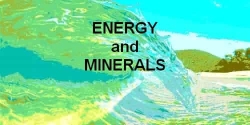Sedimentary Rocks
Sedimentary Rocks
source http://usask.ca/~mjr347/prog/geoe118/geoe118.023.htmladapted to HTML from lecture notes of Prof. Stephen A. Nelson Tulane University
occurrence
identification
general classification and mineralogy
diagnostic
structures and features
carbonate rocks
mudstones
depositional basins
sedimentary facies
images and descriptions of
common sedimentary rocks
see also E-Learning Sedimentary Rocks...
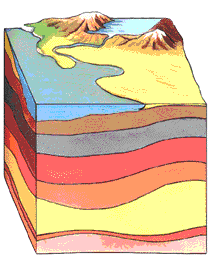
occurrence
Rivers, oceans, winds, and rain runoff all have the ability to carry the particles washed off of eroding rocks.Such material, called detritus, consists of fragments of rocks and minerals.

When the energy of the transporting current is not strong enough to carry these particles, the particles drop out in the process of sedimentation.
This type of sedimentary deposition is referred to as clastic sedimentation.
Another type of sedimentary deposition occurs when material is dissolved in water, and chemically precipitates from the water.
This type of sedimentation is referred to as chemical sedimentation.
A third process can occur, wherein living organisms extract ions dissolved in water to make such things as shells and bones.
This type of sedimentation is called biogenic sedimentation.
Thus, there are three major types of sedimentary rocks: that can be grouped by the type of particle found in the rocks.
- Siliclastic sedimentary rocks form by the accumulation of
mostly silicate mineral fragments. These include most
sandstones, mud rocks, conglomerates,
and breccias.
- Biochemical sedimentary rocks consist of fragments of
particles produced by precipitation from once living organisms.
Most of these rocks are limestones and cherts.
- Chemical sedimentary rocks are formed by direct chemical precipitation from water. While some limestones and cherts may form in this manner, evaporite deposits consisting of halite, gypsum, and other salts are the most common.
identification
Organic Sedimentary Rocks
| TEXTURE | COMPOSITION | ROCK NAME |
|---|---|---|
| Clastic | Clastic shell fragments. | COQUINA (limestone) |
| Clastic | Microscopic shells of coccoliths | CHALK |
| Altered | Microscopic siliceous organisms, recrystallized silica. | CHERT |
| Clastic | Consolidated plant remains. | COAL |
Chemical Sedimentary Rocks
| TEXTURE | COMPOSITION | ROCK NAME |
|---|---|---|
| Clastic | Calcite fragments and calcite cement. White or grey or blueish in colour. Fizzes stongly with dilute HCl. | LIMESTONE |
| Clastic | Rounded calcite ooliths and calcite cement. Can be dolomitized. | OOLITIC LIMESTONE |
| Clastic | Calcite fragments and calcite cement with significant alteration to the magnesium bearing carbonate dolomite. Fizzes with dilute HCl. | DOLOMITIC LIMESTONE |
| Clastic | Carbonate almost completely transformed to dolomite. Often yellowish or pinkish in colour. Fizzes weakly with dilute HCl. | DOLOMITE or DOLOSTONE |
| Crystalline | Halite, interlocking cubic crystals. | ROCK SALT |
| Crystalline | Halite with sylvite, interlocking cubic crystals, sometimes contains orange-to-red carnallite crystals. | POTASH |
| Crystalline | Gypsum, commonly interlocking prismatic or fibrous crystals. Usually white or light grey. | ROCK GYPSUM |
| cryptocrystalline | Iron and silica, finely banded iron and silica, precitated from ancient sea water | BANDED IRON FORMATION |
Clastic Sedimentary Rocks
| SEDIMENT PARTICLE | DESCRIPTION | ROCK NAME |
|---|---|---|
| Gravel | Rounded rock fragments. | CONGLOMERATE |
| Gravel | Angular rock fragments. | BRECCIA |
| Sand | Quartz predominant, visible grains, often thickly bedded, depositional structures such as cross-bedding common. | SANDSTONE |
| Sand | Sandstone with more than 25% feldspar grains. | ARKOSE |
| Silt | Quartz predominant, grains barely visible, gritty feel. | SILTSTONE |
| Clay | Thick beds >1cm blocky, fine mud, no particles discernable, may show polygonal cracks, composed predominantly of clay minerals and very fine quartz. | MUDSTONE |
| Clay | Laminated mudstone, fissile, splits into thin sheets. | SHALE |
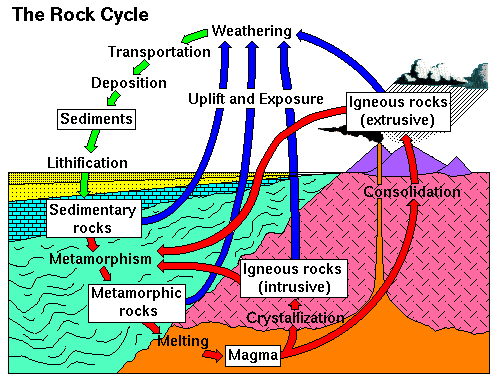
general classification and mineralogy
Because of their detrital nature, any mineral can occur in a sedimentary rock.Clay minerals, the dominant mineral produced by chemical weathering of rocks, is the most abundant mineral in mudrocks.
Quartz, because it is stable under conditions present at the surface of the Earth, and because it is also a product of chemical weathering, is the most abundant mineral in sandstones and the second most abundant mineral in mudrocks.
Feldspar is the most common mineral in igneous and metamorphic rocks. Although feldspar eventually breaks down to clay minerals and quartz, it is still the third most abundant mineral in sedimentary rocks. Carbonate minerals, either precipitated directly or by organisms, make up most biochemical and chemical sedimentary rocks, but carbonates are also common in mudrocks and sandstones.
Siliclastic sedimentary rocks can be classified on the basis of their mineral composition
In the charts Q=quartz F=feldspar L=other fragments number are in percents

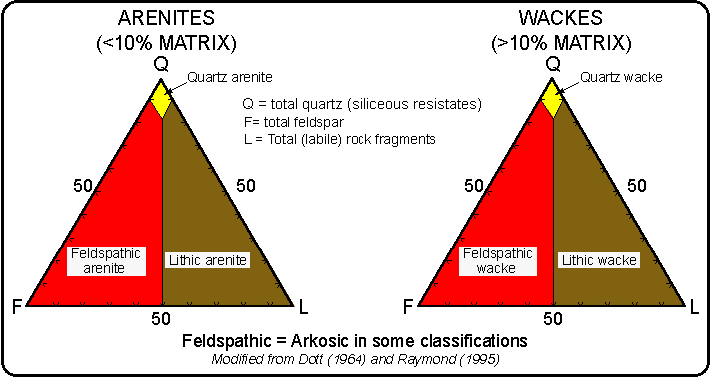
Minerals found in sedimentary rocks can be divided into 2 classes:
- Allogenic minerals - These are formed elsewhere and
transported into the area of deposition.
- Authigenic minerals - These are minerals that are formed at the site of deposition, either by direct chemical precipitation or by later diagenetic processes.
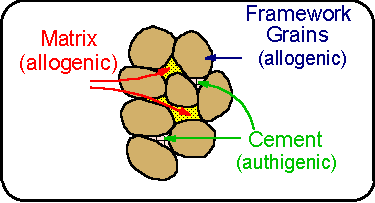
Any mineral can be an allogenic mineral, but some are more stable under the conditions present at the Earth's surface than are others. Conditions that are present at the Earth's surface and differ from those where most minerals form are:
- Low Temperature
- Low Pressure
- High free oxygen concentration
- High amounts of free liquid water
In this list, the igneous minerals have an asterisk (*). Note that the order in which they occur is in the same order that occur in Bowen's reaction series. Igneous minerals that crystallize at the highest temperatures are most out of equilibrium at the Earth's surface, and are therefore the most unstable.
Minerals that are very stable at the Earth's surface are minerals that either form as a result of chemical weathering, or crystallize at the lowest temperatures.
Authigenic minerals can also be allogenic minerals, but some are formed during diagenesis but not very stable in the transportation cycle either because they dissolve readily in water or because they are easily abraded during transportation. Thus we can divide authigenic minerals into those that are stable during diagenesis and transportation, and those that are unstable during transportation.
The longer a mineral is in the weathering and transportation cycles of sedimentary rock forming processes, the more likely it is to break down to a more stable mineral or disappear altogether.
Thus, we can classify sediments on the basis to which they have achieved mineralogical maturity
- Mineralogically mature sediments and sedimentary rocks
consist entirely of minerals that are stable near the surface.
Such sediment is considered to have been in the weathering and transportation cycle for a long amount of time.
- Mineralogically immature sediments and sedimentary rocks
consist of a high proportion of unstable minerals.
Because such minerals will not survive for a long time in the weathering and transportation cycles, sediments and rocks with high proportions of these minerals must not have been in the weathering/transportation cycle for long periods of time.
diagnostic structures and features
Since most sedimentary rocks are derived by processes of weathering, transportation, deposition, and diagenesis, the textures we find in sediment and sedimentary rocks are dependent on process that occur during each stage.These include:
- nature of the source rocks.This determines the original shape of the grains and the mineralogical composition of the original sediment.
- strength of the wind or water currents that carry and deposit the sediment.This determines whether or not grains are transported or deposited.
- deposition process also controls structures that could be preserved in the sediment and thus give clues to the environment of deposition.
- distance transported or time in the transportation process. The longer grains are in the transportation process the more likely they are to change shape and become sorted on the basis of size and mineralogy. This also controls extent to which they break down to stable minerals during the transportation process.
- biological activity with the sediment prior to diagenesis. Burrowing organisms can redistribute sediment after it has been deposited, thus erasing some of the clues to the original environment of deposition.
- chemical environment under which diagenesis occurs. During diagenesis grains are compacted, new minerals precipitate in the pore spaces, some minerals continue to react to produce new minerals, and some minerals recrystallize. What happens depends on the composition of fluids moving through the rock, the composition of the mineral grains, and the pressure and temperature conditions attained during diagenesis.
Grain Size
Clastic sediments and sedimentary rocks are classified on the basis of the predominant grain size of clasts

Note how the particle sizes small than pebble size are defined. The lower size limit of granules is 1/2 the lower size limit of pebbles, the lower size limit of coarse sand is 1/2 the lower size limit of granules, etc.
For this reason, grain size is often given in units called f (phi) units, where f is defined as follows:
f = -log2(d)
where d is the grain diameter in millimeters.This is convenient for grain size analyses of sediment, or rocks if they can be disaggregated, because sieves can be constructed where the opening of each sieve is 1/2 the size of the sieve above.
Sediment put through such a set of sieves, will be trapped in different sieves, and sorted by grain size. The amount of grains in each sieve can then be weighed to give a quantitative measure of the size distribution of sediment.
One precaution- note how the large grain sizes have negative f units
Sorting
Sorting refers to the uniformity of grain size in a sediment or sedimentary rock. Particles become sorted on the basis of density because of the energy of the transporting medium. High energy (high velocity) currents can carry larger fragments.
As the energy or velocity decreases, heavier particles are deposited and lighter fragments continue to be transported. This results in sorting due to density. If the particles have the same density, such as all grains of quartz, then the heavier particles will also be larger, so the sorting will take place on the basis of size. We can classify this size sorting on a relative basis: well-sorted to poorly-sorted.

Beach sands and dune sands tend to be well-sorted because the energy of the waves or wind is usually rather constant.
The coarser grained sediment is not carried in because the wave or wind velocity is too low to carry such large fragments, and the finer grained sediment is kept in suspension by the waves or wind.
Mountain streams, because they have many turbulent eddies where the velocity of the stream changes suddenly usually show poorly-sorted sediment on the bottom of the stream channel. Similarly, glacial till, because it is deposited in place as glacial ice melts, and is not transported by water, tends to show poor sorting.
Rounding
- During the transportation process, grains may be reduced in size due to abrasion. Random abrasion results in the eventual rounding off of the sharp corners and edges of grains.
Thus, the degree ofrounding of grains gives us clues to the amount of time a sediment has been in the transportation cycle.
Rounding is classified on relative terms as well. Note that rounding is not the same as sphericity.
Sphericity
is controlled by the original shape of the grain.

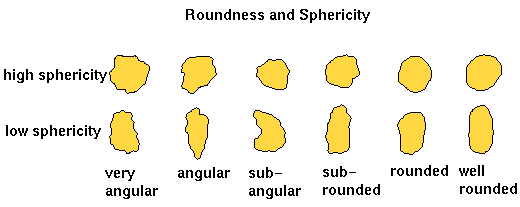
Porosity
is the percentage of the volume of the rock that is open space (pore space). This determines the amount of water or other fluids, like petroleum, that a rock can contain.
In sediments or sedimentary rocks the porosity depends on grain size, the shapes of the grains, the degree of sorting, and the degree of cementation.
Well-rounded coarse-grained sediments usually have higher porosity than fine-grained sediments, because the grains do not fit together well. Angular grains of fine grained sediment can be compacted to fit together better, and thus porosity is reduced.
Mudrocks, because of fine grain size, usually have very low porosities.
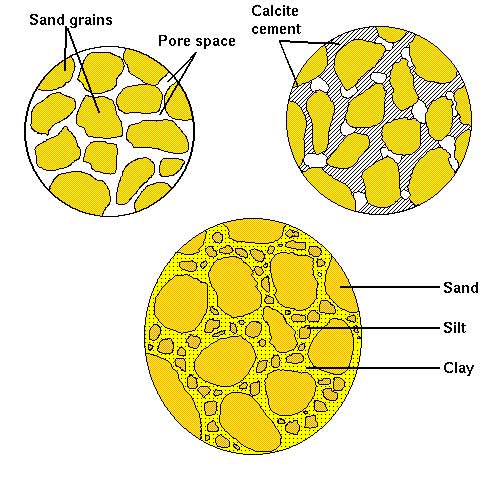
Poorly sorted sediments usually have lower porosity because the fine-grained fragments tend to fill in the open space
Cementation
that takes place during diagenesis tends to fill in the pore space. Thus, highly cemented sedimentary rocks have lower porosity than do poorly cemented sedimentary rocks.
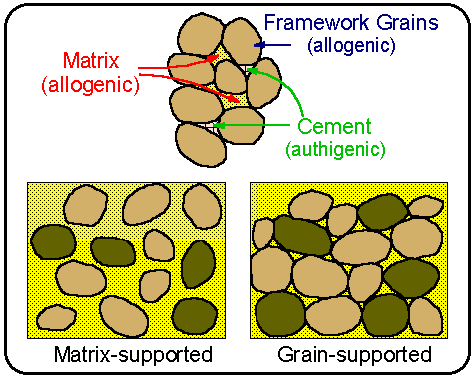
Packing of Grains
Packing refers to the arrangement of clastic grains entirely apart from any authigenic cement that may have later crystallized between them. If the clastic grains touch each other throughout, the rock is said to be grain supported.If the rock is poorly sorted and the grains are separated by a mud or silt matrix, the rock is said to be matrix supported.
Matrix-
If the rock is poorly or moderately sorted, the percentage of matrix and texture of the matrix should also be described.
Induration
Induration refers to the hardness of the rock or how easily it breaks apart.
Well indurated rocks are difficult to break with a hammer. Moderately indurated rocks can be easily broken with a rock hammer.
Poorly indurated or friable rocks break apart easily in your hand.
The term non-indurated would describe a sediment that has not undergone any cementation.
Textural Maturity
The longer sediment is involved in the transportation cycle, the more time it has to become well-sorted.
Similarly, the longer the sediment is transported, the more time is available for grains to lose their rough edges and corners by abrasion.
Thus, we consider a texturally mature sediment to be sediment that is well-sorted and well-rounded.
Note that sediment tends to become both texturally and mineralogically mature the longer it is in the transportation cycle.
Descriptions of Texture
A complete description of the texture of a sedimentary rock should include statements about each of the factors discussed above.
To summarize, these are:
- Size of the grains.
- Sorting.
- Degree of roundness and sphericity of the grains.
- An estimate of the porosity of the rock.
- Packing of the grains.
- A description of the matrix.
- Induration of the rock.
- A statement about the textural maturity of the rock.
Features that tell us which way was up are often referred to as top and bottom indicators.
structures and features
Useful sedimentary structures and the stories they tell...Stratification and Bedding
One of the most obvious features of sedimentary rocks and sediment is the layered structure which they exhibit.
Compaction
as the mass of overlying sediment pushes down, water is sqeezed our and layers are formed

The layers are evident because of differences in mineralogy, clast size, degree of sorting, or color of the different layers. In rocks, these differences may be made more prominent by the differences in resistance to weathering or color changes brought out by weathering.
Layering is usually described on the basis of layer thickness
Distinctive types of layering
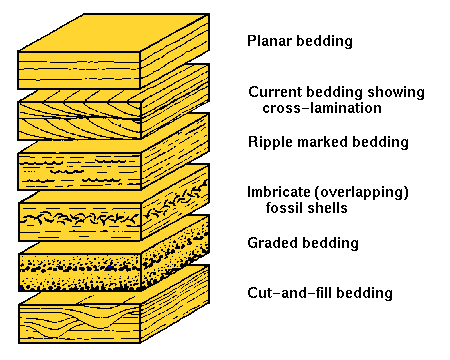
Planar bedding has little diagnostic importance but animal burrows or bed form irregularities my give an indication of way-up and environment.
Current cross bedding gives clear way-up indication as bed are truncated by the next influx of sediment. The orientation of the cross beds can also indicate the direction of water or wind currents.
Ripple-marked bedding indicates waves action and the ripple cusps point in the younging direction. Wave action usually indicate shallow marine conditions but ripples can be found in freshwater sediments also.
Imbricate bedding is the overlapping of fossil shells or platey pebbles and can be used as an indicator of current direction.
Graded bedding usually fines upwards to give an indication of way-up. Graded units represent individual pulses of sediment which may be seasonal or indicative of some other cyclic process.
Cut-and-fill bedding involves the reworking of sedimentary layers by new water channels. They provide both way-up and current direction indicators and are common in stream fluvial deposits.
Rhythmic Layering
- consists of alternating parallel layers having different properties.
This is sometimes caused by seasonal changes in deposition (Varves). i.e. lake deposits wherein coarse sediment is deposited in summer months and fine sediment is deposited in the winter when the surface of the lake is frozen.
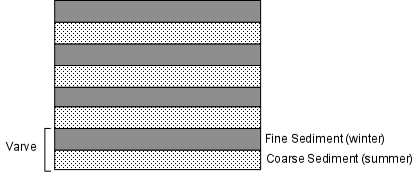
Non-sorted Sediment
-Sediment showing a mixture of grain sizes results from such things as rockfalls, debris flows, mudflows, and deposition from melting ice.
Imbricate bedding
-Elongated grains can sometimes pile up on each other to form what is called imbricate bedding. Note that imbricate bedding can be a current direction indicator if some other means is present to provide top/bottom directions.
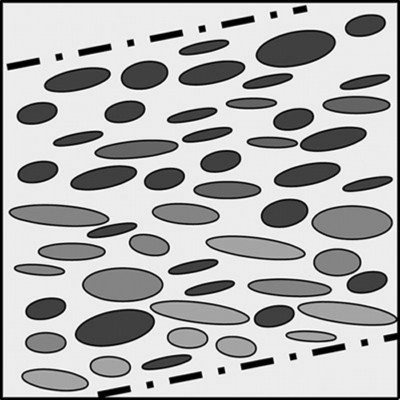
Surface Features
Symmetrical ripple marks occur in environments where there is a steady back and forth movement of the water. Such ripple marks can still be used as top and bottom indicators.
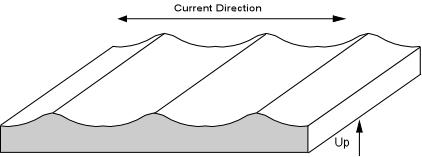
Asymmetrical Ripples give current direction and create cross bedding
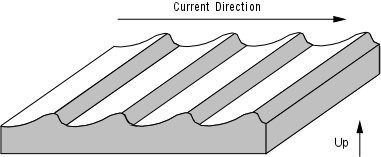

Mudcracks
- result from the drying out of wet sediment at the surface of the Earth. The cracks form due to shrinkage of the sediment as it dries. In cross section the mudcracks tend to curl up, thus becoming a good top/bottom indicator.
The presence of mudcracks indicates that the sediment was exposed at the surface shortly after deposition, since drying of the sediment would not occur beneath a body of water.

Raindrop Marks
- pits (or tiny craters) created by falling rain. If present, this suggests that the sediment was exposed to the surface of the Earth, and also are good top/bottom indicators..
Casts and Molds
-Any depression formed on the bottom of a body of water may become a mold for any sediment that later gets deposited into the depression. The body of sediment that takes on the shape of the mold is referred to as a cast.
- Load Casts - These are bulbous protrusions that are formed when
compaction causes sediment to be pushed downward into softer sediment.
- Flute Casts (Sole Marks) - Flutes are elongated depressions that form on the bottom of a body water as the current erodes. The flutes may form a mold into which new sediment is deposited. Preservation of the overlying sediment as a cast result in flute casts, which are sometimes referred to as sole marks. Flute casts are excellent indicators of current direction and tops/bottoms of beds
- Any object carried along by a current my gouge or scrape the sediment on the bottom of the body of water. Depressions, scratches, or gouges are called toolmarks and can be useful top/bottom indicators.

Tracks and Trails
-These features result from organisms moving across the sediment as they walk, crawl, or drag their body parts through the sediment.

Burrow Marks
-Any organism that burrows into soft sediment can disturb the sediment and destroy many of the structures discussed above. If burrowing is not extensive, the holes made by such organisms can later become filled with water that deposits new sediment in the holes. Such burrow marks can be excellent top and bottom indicators.
carbonate rocks
The carbonate rocks make up 10 to 15% of sedimentary rocks. They largely consist of two types of rocks.Limestones which are composed mostly of calcite (CaCO3) or high Mg calcite [(Ca,Mg)CO3], and
Dolostones which are composed mostly of dolomite [CaMg(CO3)2]
Because carbonate minerals in general are soluble in slightly acidic waters, they often have high porosity and permeability, making them ideal reservoirs for petroleum. For this reason they are well studied.
Limestone can be easily recognized in hand specimen or outcrop because of its high solubility in HCl. A drop of such acid placed on the rock will cause it to fizz due to the generation of CO2 gas. A dolostone, on the other hand, will not fizz until a fine powder is made from the rock or mineral. Also, dolostones tend to weather to a brownish color rock, whereas limestones tend to weather to a white or gray colored rock. The brown color of dolostones is due to the fact that Fe occurs in small amounts replacing some of the Mg in dolomite.
Folk Classification-
The Folk classification, which we will use in lab, is shown below.
The classification divides carbonates into two groups:
Allochemical rocks are those that contain grains brought in from elsewhere (i.e. similar to detrital grains in clastic rocks).
Orthochemical rocks are those in which the carbonate crystallized in place.
Allochemical rocks have grains that may consist of fossiliferous material, ooids, peloids, or intraclasts. These are embedded in a matrix consisting of microcrystalline carbonate (calcite or dolomite), called micrite, or larger visible crystals of carbonate, called sparite.
Sparite is clear granular carbonate that has formed through recrystallization of micrite, or by crystallization within previously existing void spaces during diagenesis.
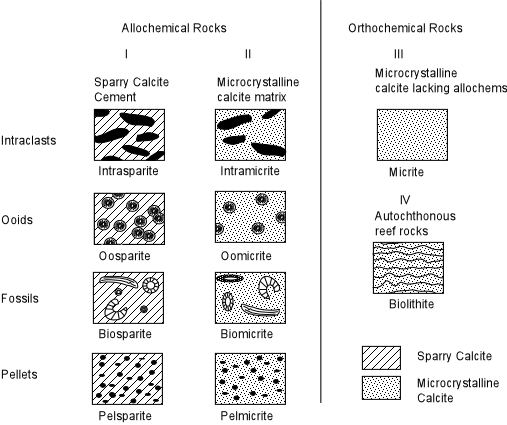
Dunham Classification.
The Dunham classification is based on the concept of grain support; further subdivided as to whether or not the grains are mud-supported or grain supported
The classification divides carbonate rocks into two broad groups called boundstones (similar to biolithite of the Folk classification)
- those whose original components were not bound together during deposition and
- those whose original components formed in place and consist of
intergrowths of skeletal material.
If the rock consists of less than 10% grains it is called a mudstone (potentially confusing if taken out of context).
If it is mud supported with greater than 10% grains it is called a wackstone.
If the rock is grain supported, it is called a packstone, if the grains have shapes that allow for small amounts of mud to occur in the interstices, and a grainstone if there is no mud between the grains.

Carbonate Depositional Environments
Most modern, and probably most ancient, carbonates are predominantly shallow water (depths <10-20 m) deposits. This is because the organisms that produce carbonate are either photosynthetic or require the presence of photosynthetic organisms. Since photosynthesis requires light from the Sun, and such light cannot penetrate to great depths in the oceans, the organisms thrive only at shallow depths. Furthermore, carbonate deposition in general only occurs in environments where there is a lack of siliciclastic input into the water. Siliclastic input increases the turbidity of the water and prevents light from penetrating, and silicate minerals have a hardness much greater than carbonate minerals, and would tend to mechanically abrade the carbonates. Most carbonate deposition also requires relatively warm waters which also enhance the abundance of carbonate secreting organisms and decrease the solubility of calcium carbonate in seawater. Nevertheless, carbonate rocks form in the deep ocean basins and in colder environments if other conditions are right.
The principal carbonate depositional environments are as follows:
- Carbonate Platforms and Shelves.
Warm shallow seas attached the continents, or in the case of epiric seas, partially covering the continents, are ideal places for carbonate deposition. Other shelves occur surrounding oceanic islands after volcanism has ceased and the island has been eroded (these are called atolls). Carbonate platforms are buildups of carbonate rocks in the deeper parts of the oceans on top of continental blocks left behind during continent - continent separation.Reef building organisms from the framework of most of these carbonate buildups.
- Tidal Flats.
Tidal flats are areas that flood during high tides and are exposed during low tides. Carbonate sands carried in by the tides are cemented together by carbonate secreting organisms, forming algal mats and stromatolites.
- Deep Ocean
Carbonate deposition can only occur in the shallower parts of the deep ocean unless organic productivity is so high that the remains of organisms are quickly buried. This is because at depths between 3,000 and 5,000 m (largely dependent on latitude - deeper near the equator and shallower nearer the poles) in the deep oceans the rate of dissolution of carbonate is so high and the water so undersaturated with respect to calcium carbonate, that carbonates cannot accumulate. This depth is called the carbonate compensation depth
(CCD)
. The main type of carbonate deposition in the deep oceans consists of the accumulation of the remains of planktonic foraminifera to form a carbonate ooze. Upon burial, this ooze undergoes diagenetic recrystallization to form micritic limestones. Since most oceanic ridges are at a depth shallower than the CCD, carbonate oozes can accumulate on the flanks of the ridges and can be buried as the oceanic crust moves away from the ridge to deeper levels in the ocean. Since most oceanic crust and overlying sediment are eventually subducted, the preservation of such deep sea carbonates in the geologic record is rare, although some have been identified in areas where sediment has been scraped off the top of the subducting oceanic crust and added to the continents, such as in the Franciscan Formation of Jurassic age in California.
- Non-marine Lakes
. Carbonate deposition can occur in non-marine lakes as a result of evaporation, in which case the carbonates are associated with other evaporite deposits, and as a result of organisms that remove CO2 from the water causing it to become oversaturated with respect to calcite.
- Hot Springs
. When hot water saturated with calcium carbonate reaches the surface of the Earth at hot springs, the water evaporates and cools resulting in the precipitation of calcite to form a type of limestone called travertine
.
Dolostones are carbonate rocks composed almost entirely of dolomite - (Ca,Mg)CO3.
Although there used to be a common perception that the abundance of dolostones increased with age of the rock, it is now recognized that although no primary dolomite bearing rocks are being directly precipitated in modern times, dolostones have formed throughout geologic time. This is true despite the fact that modern sea water is saturated with respect to dolomite. Still, most dolostones appear to result from diagenetic conversion of calcite or high-Mg calcite to dolomite, after primary deposition of the original calcium carbonate bearing minerals.
Two mechanisms of dolomitization of limestones have been proposed.
- Evaporative Reflux
. This mechanism involves the evaporation of seawater to form a brine that precipitates gypsum. After precipitation of gypsum, the brine is both enriched in Mg relative to Ca and has a higher density. If the brine then enters the groundwater system and moves downward into buried limestones. This Mg-rich brine then reacts with the calcite in the limestone to produce dolomite.
- Mixing of Seawater and Meteoric Water.
This mechanism involves the mixing of groundwater derived from the surface with saline groundwater beneath the oceans. Dolomitization is thought to occur where the two groundwater compositions mix with each in the porous and permeable limestone within a few meters of the surface.
Evaporite minerals are those minerals produced by extensive or total evaporation of a saline solution. Because such minerals dissolve readily in less saline rich solutions, like most groundwater and surface water, evaporite rocks rarely outcrop at the surface except in aid regions. Evaporite rocks are common, however, in the subsurface. Three different environments result in the deposition of evaporites.
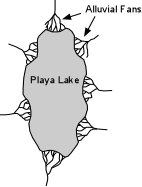 1.
1.  2.
2.  3.
3.
- Basins of internal drainage.
In arid regions with basins of internal drainage rainfall in the adjacent areas is carried into the basin by ephemeral streams carrying water and dissolved ions. The water fills the low points in the basin to form a playa lake. These lakes eventually evaporate, resulting in the precipitation of salts such as halite, gypsum, anhydrite, and a variety of other salts not commonly found in marine evaporite deposits, such as trona (NaHCO3.Na2CO3.2H2O), natron (Na2CO3.10H2O), nahcolite (NaHCO3), mirabilite (Na2SO4.10H2O), borax (Na2B4O5(OH)4.8H2O), kernite [Na2B4O6(OH)2.3H2O], and colemanite (CaB3O4(OH)3.H2O).
- Restricted bays or seas.
In areas where there restricted input of fresh or marine waters into a basin, coupled with extensive evaporation within the basin, dissolved ion concentrations may increase to the point where form a dense concentrated solution is formed near the surface.These dense saline waters then sink within the basin, become oversaturated with respect to salts like gypsum and halite, and precipitate the salts on the floor of the basin. - Shallow arid coasts or sabkhas
Along shallow arid coastlines where input of fresh water is rare and evaporation increases the salinity of the marine water, evaporation may increase the salinity of the water to a point where evaporite minerals like halite and gypsum are precipitated.
Chert is a mineralogically simple rock consisting of microcrystalline quartz.
There are three common occurrences of chert.
- As nodules and silt-sized grains in carbonate rocks. Chert nodules, as discussed previously, occur as structureless dense masses within carbonate rocks. They range in size from a few centimeters to many meters in length. The source of silica is likely silica secreting organisms that include diatoms (Jurassic to Holocene), radiolaria (Ordovician to Holocene), and sponges (Cambrian to Holocene). But, these organisms are not preserved in the chert nodules. Instead, the remains of these organisms were likely dissolved by fluids flowing through the rock during diagenesis. Most chert nodules are found along bedding planes in the carbonate rocks, likely because these were zones along which fluids that precipitated the microcrystalline quartz were able to move.
- As bedded cherts that formed along tectonically active continental margins. Bedded cherts occur in association turbidites, ophiolites, and mélanges (oceanic trench deposits scraped off the seafloor at subduction zones). The beds range in thickness from a few centimeters to several meters, and are interbedded with siliceous shales. Although thought to represent deep water accumulations of silica secreting organisms, they may also form in warm nutrient rich shallow water environments. Sometimes the remains of silica secreting organisms, like radiolaria, sponge spicules, or diatoms are preserved in the cherts, but most show a microcrystalline texture that results from recrystallization during diagenesis
- Associated with hypersaline-lacustrine deposits. Although less common than the previously discussed occurrences of chert, some cherts appear to form in a hypersaline environment where they are associated with evaporite deposits. Such cherts may in fact form as a result of replacement of sodium silicate evaporite minerals like magadiite by the following chemical reaction:
magadiite
Since mechanisms 1 and 2 generally require the presence of silica secreting organisms in order to form chert, the occurrence of chert in Precambrian rocks is problematical because no such organisms existed prior to the early Paleozoic. Such Precambrian cherts may have actually formed by direct chemical precipitation from silica oversaturated seawater.
mudstone rocks
Mudrocks are fine grained sedimentary rocks consisting of mostly silt and clay size fragments. They are sometimes called argillites Because of their small grain size, they are difficult to study, even with the petrographic microscope. But, they are important rocks because they are the most abundant sedimentary rocks, making up over 65% all sedimentary rocks, are likely the source rocks for petroleum and natural gas, and are sometimes valuable ore deposits. In addition, the mudrocks are the protoliths (precursor rock) for aluminous metamorphic rocks, ClassificationClassification of mudrocks is mainly based on observations one can make in the field or at the level of a hand specimen. The classification depends on the grain size of the minerals making up the rock and whether or not the rock is fissile or non-fissile. A fissile rock tends to break along sheet-like planes that are nearly parallel to the bedding planes. Fissility is caused by the tendency of clay minerals to be deposited with their sheet structures [(001) crystallographic planes] parallel to the depositional surface.
| Grain Size | Description | Fissile Rock | Nonfissile Rock |
|---|---|---|---|
| >2/3 silt | Abundant silt sized grains visible with a hand lens | Silt-shale | Siltstone |
| >1/3, <2/3 silt | Feels gritty when chewed | Mud-shale | Mudstone |
| >2/3 clay | Feels smooth when chewed | Clay-shale | Claystone |
Elements of texture that can be observed in mudrocks include the shapes of the grains, the fissility or lack of fissility, and laminations.
Grain shape
Clay minerals are generally angular and sheet like, reflecting their crystal structure, which is also why most mudrocks are fissile.
Silt size quartz grains are usually angular or platy shaped.
Little rounding occurs because these minerals are so small that they can be kept in suspension in very low energy currents, with little chance of impact with other grains that would normally cause abrasion and rounding.
Fissility
. Whether or not a mudrock is fissile or non-fissile depends on several factors.
- The abundance of clay minerals. The more clay minerals
contained in the rock, the more likely the rock is to be fissile.
- The degree of preferred orientation of the clay minerals.
Small clay minerals tend to adhere to one another if they collide
during transport. The tendency is increased by increased
salinity of the water and the presence of organic matter in the water.
Adhesion of small mineral grains is referred to as
flocculation. If the clay minerals flocculate, then they are less
likely to have a preferred orientation, and thus less likely to form
rocks with fissility.
- Bioturbation of organisms within or on the surface of the sediment
can disturb the preferred orientation of clay minerals, and thus lead
to a non-fissile rock.
- If the clay minerals recrystallize during diagenesis they will tend
to do so with a preferred orientation with their (001) crystal planes
oriented perpendicular to the maximum principal stress
direction. (This process also results in slatey cleavage and
foliation in metamorphic rocks). If diagenesis occurs shortly
after deposition, then it is likely that the maximum principal stress
direction will also be oriented perpendicular to the bedding planes.
Laminations are parallel layers less than 1 cm thick. Such laminations can be seen as differences in grain size of the clasts in different laminae - due to changes in current velocity of the depositing medium, or could be due to changes in the organic content and oxidation conditions at the site of deposition of the different layers.
Environments of Deposition
Mudrocks represent texturally and mineralogically mature sediments deposited in low energy environments. The fine grain size of these sediments means that that the sediment can be suspended for long times in relatively quiet, low energy currents. This results in deposition on the abyssal plains of the oceans, at the distal ends of deltas, in quiet lakes and swamps, and as wind blown dust. Large deposits of wind blown dust are called loess, and consist of mostly silt-sized fragments. While the small fragments can be transported into lakes and oceans easily by streams, it is likely that large quantities of these fragments could also reach the oceans by wind transport.
depositional basins
In order for sediment to be deposited, a low lying area, called a basin, is required. The largest of basins are the ocean basins, which currently cover about 70% of the Earth's surface. In the past, however, sea level has often changed, resulting in episodes where even the continents were covered by shallow seas, referred to as epiric or epicontinental seas. When sea level rises to invade the continents it is referred to as a transgression.It is for these reasons that most of the sedimentary rocks preserved in the geologic record are marine sediments.
Basins result from plate tectonics, and even the large transgressions appear to be related to tectonic factors, as increased spreading rates in the ocean basins can result in changing the configuration of ocean basins that result in flooding of the continents.
sedimentary facies
A sedimentary facies is a group of characteristics that reflect a sedimentary environment different from those elsewhere in the same deposit. Thus, facies may change vertically through a sequence as a result of changing environment through time. Also, facies may change laterally through a deposit as a result of changing environments with distance at the same time.The structures and textures found in sedimentary rocks give clues to the environment of deposition, as discussed above, and thus allow geologists to assign parts of a deposit to a particular sedimentary facies. Individual facies are generally described in terms of the environment is which deposition occurred.
The following are facies or environments are among those possible:
| I. Terrigenous or Non-marine Facies | II. Near Shore Facies |
|---|---|
|
|
| III. Shallow Marine (depths < about 200 m) | IV. Deep Marine Facies |
|
|
images and descriptions of common sedimentary rocks
"click on a name to see an image and description of the rock..."banded iron formation
chert
coal
conglomerate
dolomite
halite
limestone
sandstone
sedimentary breccia
shale
siltstone

